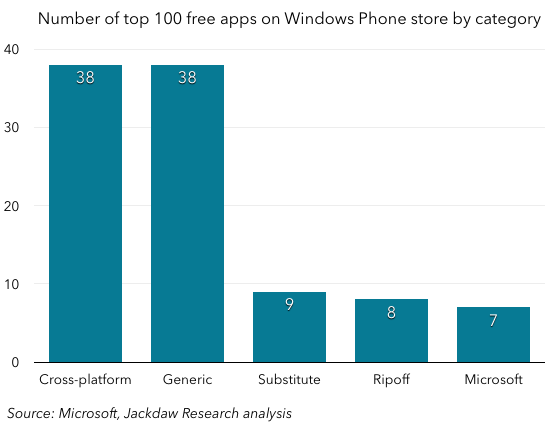Much has been written in the past about Windows Phone’s lack of apps compared with iOS and Android. Both Nokia and Microsoft have responded in the past with claims that quality and not quantity is what matters in an app store. Both arguments represent over-simplifications, and neither accurately captures the reality of what’s going on with the Windows Phone app store and its competitiveness with Android and iOS. This post is a summary of one of the major sections of a new report on the state of Windows Phone published by Jackdaw Research this week, which examines this question among others in depth. The report is available for free here, and I encourage interested readers to download it and read the whole thing.
The quantity gap
Windows Phone does suffer from a quantity gap versus both Android and iOS, which are essentially neck and neck in the app store stakes. On the one hand, Microsoft has done well to get out of the gate quickly and get a good number of apps on the platform in a short space of time – the chart below shows the number of apps on each of the three major platforms within the first 15 quarters following launch:
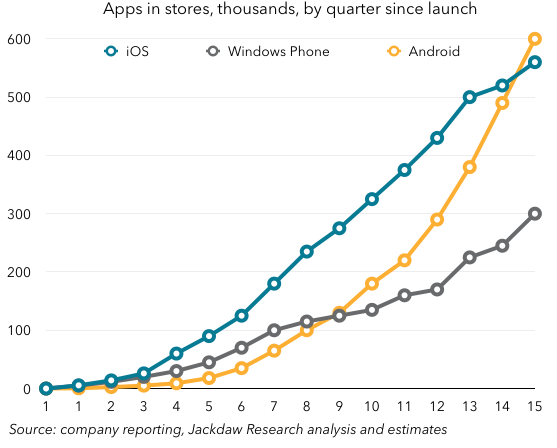 The problem, of course, is that Windows Phone isn’t competing against those platforms 15 quarters from their launch – they launched considerably earlier, and the current situation is much less favorable:
The problem, of course, is that Windows Phone isn’t competing against those platforms 15 quarters from their launch – they launched considerably earlier, and the current situation is much less favorable:
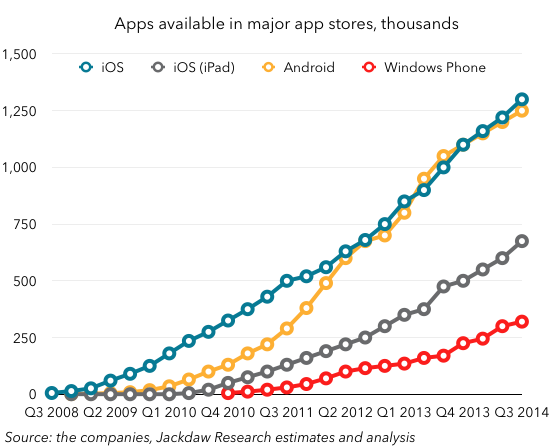 Windows Phone continues to lag the other two major app stores (and even Apple’s iPad-specific list of apps) considerably, and the gap is widening rather than narrowing.
Windows Phone continues to lag the other two major app stores (and even Apple’s iPad-specific list of apps) considerably, and the gap is widening rather than narrowing.
The quality gap
The frequent response from Nokia (before its acquisition by Microsoft) and from Microsoft itself has been that Android and iOS have thousands of apps no-one needs or uses, and that the real question is one of quality rather than quantity. But the problem is that Windows Phone suffers from a lack of quality as well as a quantity problem. There are several ways to look at that, so I’ll run through a few of them.
Firstly, I’ve broken down the top 100 apps in the Windows Phone store by type, according to the following categorization (I did the analysis a few weeks ago, so the numbers may have changed marginally since):
- Cross-platform – apps which are also available on one or both of the other two major app stores and therefore have strong cross-platform appeal. These make up the bulk of the top 100 apps on the other two major platforms.
- Generic – apps which serve generic needs (such as flashlights, MP3 downloaders etc) but aren’t from name brands, and aren’t available on the other major stores. These make up a smaller percentage of apps on iOS and Android.
- Substitute – apps which provide substitutes for apps which either don’t exist at all on Windows Phone or where the current versions available are meeting a need so poorly others spring up to fill the need, e.g. 6tin (a Tinder substitute) or Snaptastic (a Snapchat substitute). These tend not to exist on iOS, and exist in specific niches on Android.
- Ripoff – a strong word, but used only where a competing app directly uses the name of an existing brand and/or uses the company’s logo without permission in promoting itself. This is particularly egregious in the case of YouTube apps. These are present on the other two major platforms as well, but tend not to make it into the top 100 lists.
- Microsoft – apps which Microsoft itself develops.
The picture is somewhat grim even in the top 100. Just over a third are apps also found in the other two major app stores, far lower than the equivalent percentages for iOS and Android. Another third are generics, many of them music downloaders, flashlights and the like (one or two of which also appear in the top 100 on Android and iOS). Nine are substitutes for popular apps not available (or not available in ideal form) on Windows Phone, including Snapchat, Tinder, Instagram, Google Maps and YouTube. Eight are what we’ve called Ripoffs, almost all of them YouTube apps, but also including counterfeit Gmail, Google Chrome and Wikipedia apps. Lastly, seven are developed by Microsoft itself. Using the top 100 as a barometer for the overall Windows Phone Store experience is not all that promising.
Another way to look at the quality issue is to compare the top 50 apps in the three major stores and look at crossover – in other words, focus in on the “cross-platform” category above. The chart below shows this breakdown:
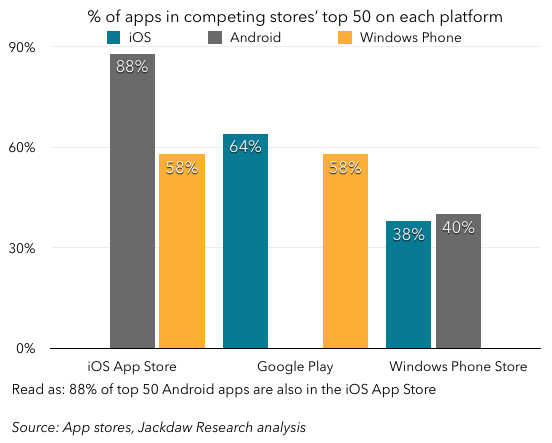 Here, too, Windows Phone comes off poorly, since the store only has 38% of the top 50 iOS apps and 40% of the top 50 Android apps, which compares unfavorably with both Google Play and iOS App Store.
Here, too, Windows Phone comes off poorly, since the store only has 38% of the top 50 iOS apps and 40% of the top 50 Android apps, which compares unfavorably with both Google Play and iOS App Store.
The time gap
Microsoft has worked hard to port key apps over from competing platforms, and makes a big deal out of these apps’ arrival on Windows Phone. But if quantity is the first problem and quality is the second, the third major gap with Windows Phone is the time lag between when major apps appear on iOS and Android and when they appear on Windows Phone. The full report contains a detailed breakdown of this analysis, but the chart below presents a summary of the time lag for some major apps:
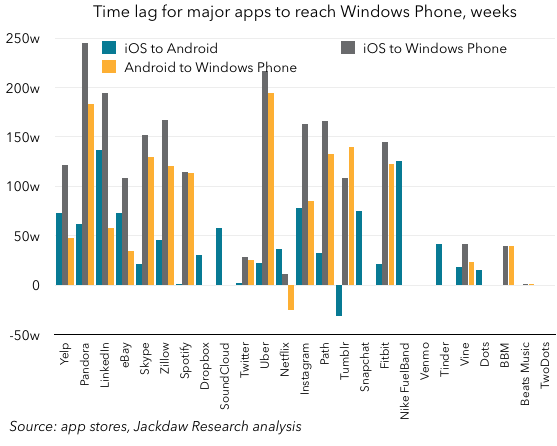 As you can see from the chart, the time lag in question has been as long as almost 250 weeks (i.e. almost five years) to as short as 30 weeks, but very few major apps have come in shorter than that. In addition, in quite a number of cases, apps simply still aren’t available: notable examples include Dropbox (launched on iOS September 2009), SoundCloud (November 2009), Snapchat (July 2011), Venmo (March 2012) and Tinder (September 2012). When these apps do arrive, they’ve often lost their “hot new thing” status and the next big thing is still nowhere to be found on Windows Phone.
As you can see from the chart, the time lag in question has been as long as almost 250 weeks (i.e. almost five years) to as short as 30 weeks, but very few major apps have come in shorter than that. In addition, in quite a number of cases, apps simply still aren’t available: notable examples include Dropbox (launched on iOS September 2009), SoundCloud (November 2009), Snapchat (July 2011), Venmo (March 2012) and Tinder (September 2012). When these apps do arrive, they’ve often lost their “hot new thing” status and the next big thing is still nowhere to be found on Windows Phone.
Read the report for more details
The full report has the rest of the detail on this analysis, but also more analysis on what ails Windows Phone, what Microsoft is doing about it, and what I think they should do about it. It’s available for free here (you’ll need to provide an email address to receive the download link but it will never be used for anything else), and I recommend reading the whole thing if this topic is of interest.
